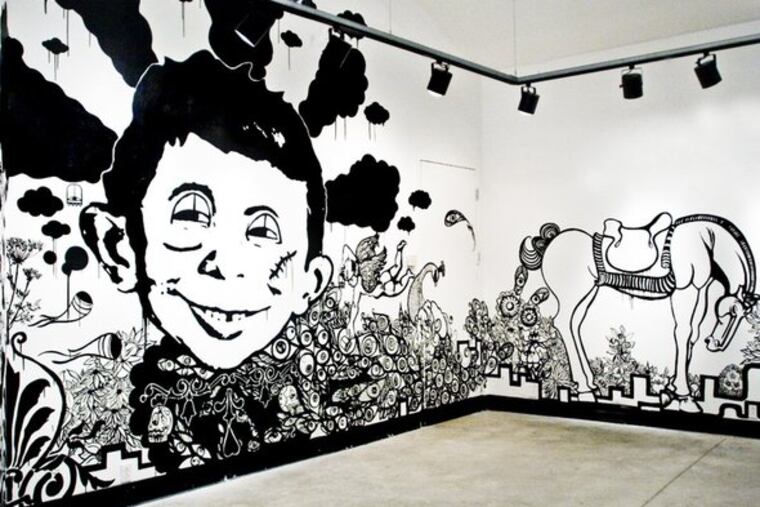Galleries: A trippy narrative mural explores time and perception
Wonderful shows used to be unheard of in August. No more. The energetic, free-association painting covering the interior of Drexel University's Leonard Pearlstein Gallery makes for one of the most engaging, memorable shows this gallery has ever seen.

Wonderful shows used to be unheard of in August. No more. The energetic, free-association painting covering the interior of Drexel University's Leonard Pearlstein Gallery makes for one of the most engaging, memorable shows this gallery has ever seen.
"Semiopticon," a black-and-white mural painted directly on the gallery's four walls by Thomas Buildmore and Morgan Thomas, takes its title from semiotics and the Panopticon. Semiotics, the study of sign processes, or signification, and how meaning is constructed, has inspired the bizarre but intuitive flow of imagery this mural depicts as you enter the gallery, look to your left, and begin to follow its trippy narrative, which eventually ends at the right of the entrance.
Its structure, one learns, is based on the Panopticon, a prison design that allows observers to view prisoners without the prisoners' knowing whether they are being watched.
As this crisp, cartoony spectacle of creation, religion, pop stars, profanity, and undefiled nature unfolded, I was reminded of Gabriel Garcia Marquez's One Hundred Years of Solitude and its ambiguous sense of time. Like that novel, "Semiopticon" seems to suggest that different periods of time can be experienced simultaneously - a collapse that, in "Semiopticon," takes place literally on the same plane of time. In Buildmore and Thomas' story, Jean-Michel Basquiat comes right after the American Indians, but before Marilyn Monroe and L'il Orphan Annie.
But it's the shadow of Andy Warhol that looms most powerfully over "Semiopticon," and not just for its portrayals of Basquiat and Monroe and its clever imitations of screen-printing. The 15 minutes of fame the pop artist so famously predicted for everyone, some day, have finally met their mural.
Re-Jenny-ation
Jenny Jaskey, who closed her Northern Liberties gallery in the spring to try life as an independent curator in New York, is still here in spirit, with an impressive group show she has organized for Tiger Strikes Asteroid called "No Objective." Not coincidentally, the works of these five New York-based artists, all of whom use found materials and recycling in inventive ways, would have fit nicely into Jaskey's hulking former space. As it is, they make out surprisingly well in the Tiger's tidy quarters.
A close examination of Ivin Ballen's initially unprepossessing wall sculpture will likely reveal it to be something entirely different from what you thought it was. Among other things, the duct tape supposedly holding it all together is an inverse cast of duct tape, painted that familiar lustrous graphite gray.
Skyler Brickley - using a small, conventional paint roller to apply long, uninterrupted, contiguous strips of black paint to the wall - has created a kind of decorative painting that allows for the idiosyncracies of memory foam, while its transparent application of black also manages to evoke painted or screen-printed renditions of strips of film (right down to what appear to be sprocket holes, produced again, apparently, by the foam's memory). Yet another instance of Warhol's reverberations in contemporary art.
The opposite wall of the gallery has been turned over to Ethan Greenbaum, who has covered it with sheets of paper printed with dummy type, into which another artist, David Scanavino, has inserted his rectangular blocks of newspaper pulp (talk about dire predictions for the newspaper industry).
Lisha Bai's mesmerizing, slightly sparkly cube of black sand mixed with resin that's presumably been cast into its geometric shape, is the unapologetic beauty of the show. Mounted on a tall glass pedestal, it suggests a relic of minimalism abducted by space aliens.